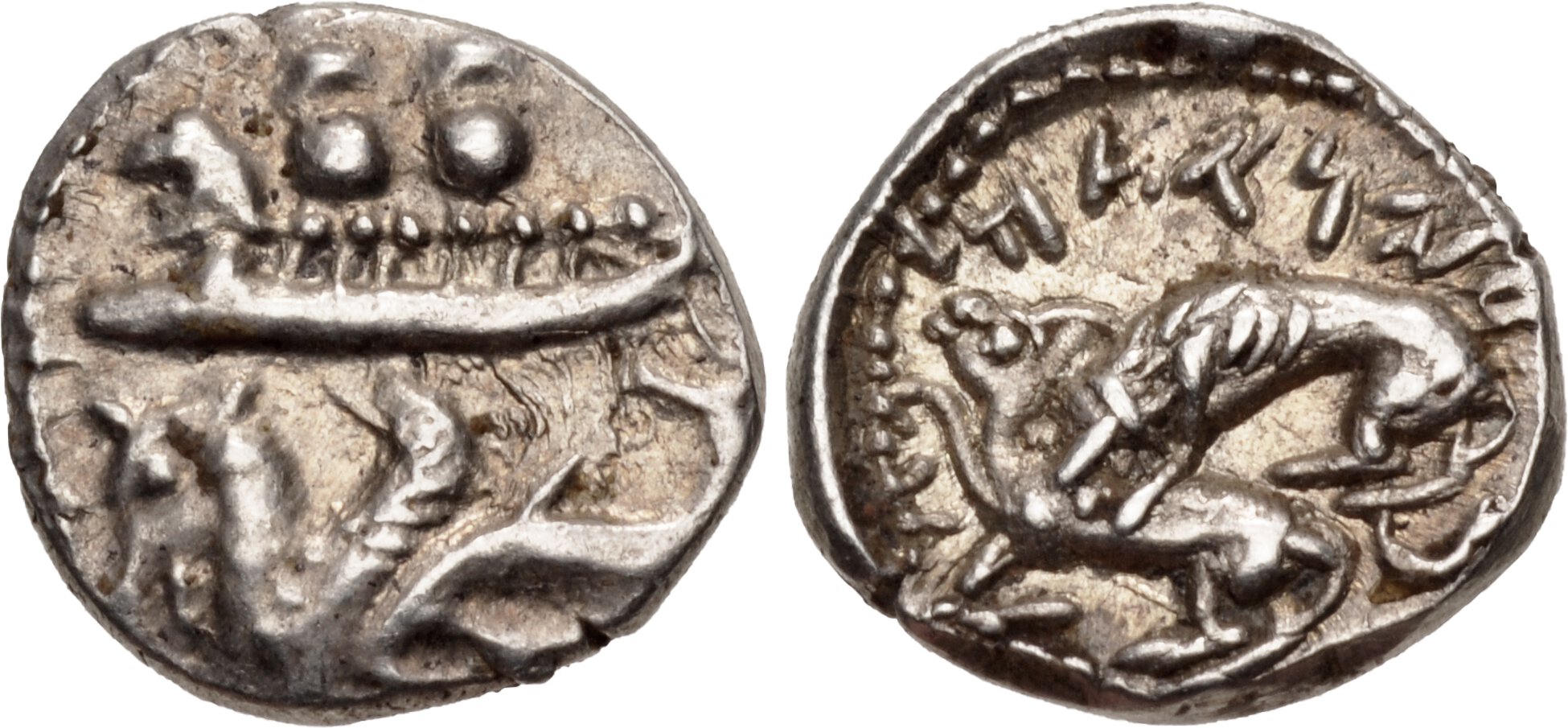S 1826 - Byblus (Aynel), silver, 16th shekels (350-333 BCE)
From SILVER
350 BCE - 333 BCE Silver 814 kg
Description
| ObverseInscription or printing placed on the obverse.: | Two hoplites, holding shields, on galley left above waves, prow ending in lion's head, below, hippocamp left |
| ReverseInscription or printing placed on the reverse.: | 'YN'L MLK GBL (= 'Aynel, king of Gebal, in Phoenician) around (Aramaic).Lion attacking bull left |
Mint and issuing power
| MintIdentifies the place of manufacture or issue of a numismatic object.: | Byblus | Ancient regionAncient region.: | Phoenicia | Modern countryModern country: Lebanon | AuthorityIdentifies the issuing power. The authority can be "pretended" when the name or the portrait of X is on the coin but he/she was not the issuing power. It can also be "uncertain" when there is no mention of X on the coin but he/she was the issuing power according to the historical sources: |
Chronology
| FromIdentifies the initial date in a range assigned in a numismatic context. | 350 BCE | toIdentifies the final date in a range assigned in a numismatic context.. | 333 BCE | PeriodTime period of the numismatic object.: Classical 480-323 BC |
Physical description
| MetalThe physical material (usually metal) from which an object is made.: | Silver |
Median weightMedian of the weights of numismatic objects (in grams). in grams | 0.75 | DenominationTerm indicating the value of a numismatic object. Examples: tetradrachm, chalkous, denarius.: | 16th shekel | StandardStandard.: | Persian |
Image

S1826 Byblus Aynel 16th shekels (350-333 BCE).jpg [1]
References
| Die study referencePublication of the study: | Elayi - Elayi 20141Elayi - Elayi 2014, p. 245-297 and 297-305, n° 966-1473 and 1478-1543 | ||
| Coin series referenceReference to coin series study: | Sear II2Sear II, n° 6014, HGC 103HGC 10, n° 139 | ||
Obverse dies distribution
| FrequencyFrequency of specimen in distribution. ᵖ | Number of obversesNumber of obverse dies. ᵖ (o) | % (o) | Number of coinsNumber of coins. (n) | % (n) | Die nameName(s) of the die(s). |
| 1 | 18 | 34.62 | 18 | 4.55 | 1, 6, 8, 10, 19, 28, 29, G4, G6, G7, G8, G9, G10, G11, G12, G13, G14, G15 |
| 2 | 13 | 25 | 26 | 6.57 | U9, 4, 5, 7, 9, 18, 25, 26, 27, G1, G2, G3, G5 |
| 3 | 3 | 5.77 | 9 | 2.27 | 2, 20, 24 |
| 4 | 2 | 3.85 | 8 | 2.02 | U10, U11 |
| 6 | 1 | 1.92 | 6 | 1.52 | 17 |
| 7 | 1 | 1.92 | 7 | 1.77 | 16 |
| 8 | 2 | 3.85 | 16 | 4.04 | U12, 22 |
| 9 | 3 | 5.77 | 27 | 6.82 | 21, 23, GL1 |
| 10 | 2 | 3.85 | 20 | 5.05 | 13, 14 |
| 11 | 1 | 1.92 | 11 | 2.78 | 15 |
| 12 | 1 | 1.92 | 12 | 3.03 | U13 |
| 16 | 1 | 1.92 | 16 | 4.04 | 12 |
| 21 | 2 | 3.85 | 42 | 10.61 | U14, 21 |
| 60 | 1 | 1.92 | 60 | 15.15 | U15 |
| 118 | 1 | 1.92 | 118 | 29.8 | 3 |
| Total | 52 of 52 | 100 | 396 of 396 | 100.02 |
Reverse dies distribution
no distribution is available
Quantification
| Number of obversesNumber of obverse dies. ᵖ (o) | 52 | Number of singletons (o1)The number of singleton coins. ᵖ | 18 |
| Number of reverse diesNumber of reverse dies. (r) | 75 | Number of coinsNumber of coins. (n) | 396 |
| Coins per obverse dieNumber of coins per obverse die. (n/o) | 7.62 | Coins per reverse dieNumber of coins per reverse die. (n/r) | 5.28 |
| Reverse per obverse ratioRatio of obverse dies divided by reverse dies. (r/o) | 1.44 | Percentage of singletons (o1)number of coins (n) divided by the number of singletons (o1) ᵖ | 34.62 % |
| Original number of dies (O) (Carter 1983 formula)The estimation of the number of coins according to Carter 1983 ᵖ | 54.26 | Coins struck if 20,000 as average productivity per dieCoins made if the average productivity for obverses (according to Carter) is 20,000. ᵖ | 1,085,200 |
| Original number of dies (O) (Esty 2011 formula)The estimation of the number of coins according to the singleton formula in Esty 2011 ᵖ (O) | 59.86 | Survival rate if 20,000 as average productivity per dieSurvival rate if average productivity is 20,000. ᵖ | 0.00036 |
| Coverage (o = % of O) (Esty 1984 formula)Esty 1984 - coverage (% of O) ᵖ (o = % of O) | 95.45% | Die productivity if survival rate 1/2,000Average productivity if survival rate is 1/2,000. ᵖ | 14,596.39 |
| Weight of silver (in kg) if 20,000 coins per die (O = Carter formula)Carter 1983 * Median weight * 20000 (*10 if gold or electrum) ᵖ | 814 kg <br /> 814 kg | Die productivity if survival rate 1/5,000Average productivity if survival rate is 1/5,000. ᵖ | 36,490.97 |
Remarks
Most likely one single workstation U9-U15 are common with Urimilk;